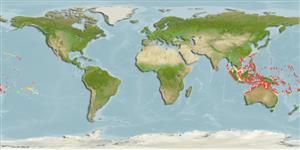Issue
The synonym P. quadrispinosa (Weber, 1913) is valid and redescriberd according to Johnson & White, 2012 (Ref. 90268).
Environment: milieu / climate zone / depth range / distribution range
Ecologia
marinhas associadas(os) a recifes; intervalo de profundidade 0 - 100 m (Ref. 128797). Tropical; 30°N - 24°S
Indo-West Pacific: India and Sri Lanka to Tonga (Ref. 53797); , Ryukyu Islands and the Great Barrier Reef to the Marshall Islands and Samoa. Recently recorded from
Tamanho / Peso / Idade
Maturity: Lm ? range ? - ? cm
Max length : 24.0 cm TL macho/indeterminado; (Ref. 48636)
Espinhos dorsais (total): 4 - 5; Raios dorsais moles (total): 20-21; Espinhos anais 1; Raios anais moles: 17. A row of small blackish spots in outer third of anal fin (Ref 42740). Males develop a conspicuous ocellus on each side of the nape (Ref. 1602). Young are best identified by the patch of small spots on the cheek that usually remains evident in adults (Ref. 48636).
Inhabits both clear lagoon and seaward reefs, in areas of open sand and rubble as well as on rocky surfaces between coral heads. Also in current prone channels (Ref. 48636). May be found solitary or form small groups (Ref. 90102).
Life cycle and mating behavior
Maturidade | Reprodução | Desova | Ovos | Fecundidade | Larvas
Randall, J.E., G.R. Allen and R.C. Steene, 1990. Fishes of the Great Barrier Reef and Coral Sea. University of Hawaii Press, Honolulu, Hawaii. 506 p. (Ref. 2334)
Categoria na Lista Vermelha da IUCN (Ref. 130435)
Ameaça para o homem
Harmless
Utilização humana
Mais informação
Nomes comunsSinónimosMetabolismoPredadoresEcotoxicologiaReproduçãoMaturidadeDesovaAgregação para desovaFecundidadeOvosDesenvolvimento dos ovos
ReferênciasAquaculturaPerfil para aquaculturaEstirpesGenéticaElectrophoresesHereditariedadeDoençasProcessamentoNutrientsMass conversion
Ferramentas
Relatórios especiais
Descarregue XML
Fontes da internet
Estimates based on models
Preferred temperature (Ref.
123201): 26.1 - 29, mean 28 °C (based on 586 cells).
Phylogenetic diversity index (Ref.
82804): PD
50 = 0.5000 [Uniqueness, from 0.5 = low to 2.0 = high].
Bayesian length-weight: a=0.00692 (0.00311 - 0.01538), b=3.06 (2.88 - 3.24), in cm total length, based on LWR estimates for this Genus-body shape (Ref.
93245).
Nível Trófico (Ref.
69278): 3.6 ±0.4 se; based on size and trophs of closest relatives
Generation time: 1.4 ( na - na) years. Estimated as median ln(3)/K based on 1
growth studies.
Resiliência (Ref.
120179): Elevada, tempo mínimo de duplicação da população menor que 15 meses (Preliminary K or Fecundity.).
Fishing Vulnerability (Ref.
59153): Low vulnerability (18 of 100).
Nutrients (Ref.
124155): Calcium = 87.2 [47.6, 133.7] mg/100g; Iron = 0.685 [0.432, 1.101] mg/100g; Protein = 18.2 [15.9, 20.1] %; Omega3 = 0.0982 [, ] g/100g; Selenium = 36.4 [19.8, 69.6] μg/100g; VitaminA = 70.1 [25.2, 189.7] μg/100g; Zinc = 1.4 [1.0, 2.0] mg/100g (wet weight);
